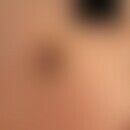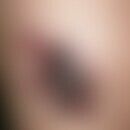HistoryThis section has been translated automatically.
DefinitionThis section has been translated automatically.
Amiodarone (Amiodarex®, Amiohexal®, Cordarex®, Tachydarone®), an iodinated benzofuran derivative, is a potassium antagonist used as a class III antiarrhthmic agent, particularly for supraventricular and ventricular tachycardia. Dermatologic UAWs include slate-gray dyschromias on light-exposed skin areas.
You might also be interested in
Occurrence/EpidemiologyThis section has been translated automatically.
0.5-10% of patients treated with amiodarone show dose-dependent discoloration. 0.1-0.3% of patients develop full vision.
EtiopathogenesisThis section has been translated automatically.
ManifestationThis section has been translated automatically.
LocalizationThis section has been translated automatically.
ClinicThis section has been translated automatically.
Usually long latency period of at least 10-12 months between first use of amiodarone and appearance of initial symptoms. Initial erythema in about 30-40% of patients, especially on the face. Later, blue or gray dyschromia in light-exposed areas. Skin folds and furrows are usually excluded.
HistologyThis section has been translated automatically.
Plaque-like, perivascular conglomerates of yellow-brown color complexes (lipofuscin) in the upper dermis. The "degeneration pigment" lipofuscin, a protein and cholesterol containing mixture of lipophilic and argentophilic pigments and is taken up by lyosomes and histiocytes. Extracellular pigment does not occur.
DiagnosisThis section has been translated automatically.
General therapyThis section has been translated automatically.
External therapyThis section has been translated automatically.
Progression/forecastThis section has been translated automatically.
LiteratureThis section has been translated automatically.
- Dereure O (2001) Drug-induced skin pigmentation. Epidemiology, diagnosis and treatment. Am J Clin Dermatol 2: 253-262.
- Dissemond J et al (2003) Hyperpigmentation of the face. Dermatologist 54: 994-998
- Drosner M, Worret WI, Marquart KH (1990) Amiodarone hyperpigmentation. Akt Dermatol 16: 67-69
- Korting HC, Kolz R, Schmoeckel C, Balda BR (1981) Amiodarone pigmentation. A rare but typical drug side effect. Dermatologist 32: 301-305
- Levine N (2004) Grayish discoloration in symmetrical pattern on hands. Drug used for cardiac condition may produce skin problem. Geriatrics 59: 32
- Murphy RP, Canavan M. Skin discoloration from Amiodarone. N Engl J Med. 2020 Jan 16;382(3):e5.
- Vestesaeger M, Gillot G, Rasson G (1967) Etude clinique d'une nouvelle medication anti-angoreuse. Acta Cardiol 22: 483-500
Incoming links (5)
Amiodarone; Base gel emulsifying hydrophobic (dac); Cutis aurantiasis; Dyschromia; Pigment;Outgoing links (5)
Amiodarone; Base gel emulsifying hydrophobic (dac); Camouflage; Dyschromia; Light protection;Disclaimer
Please ask your physician for a reliable diagnosis. This website is only meant as a reference.











